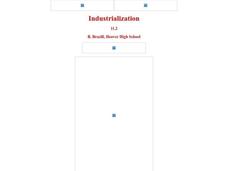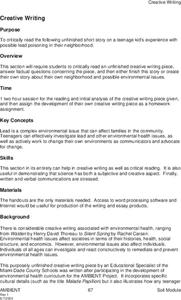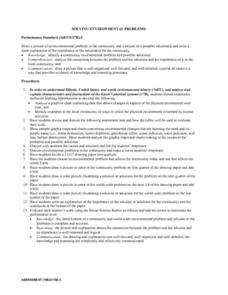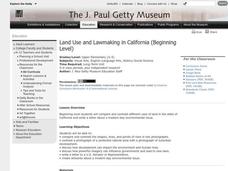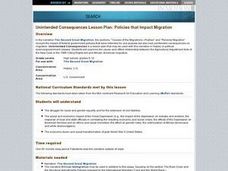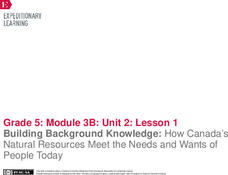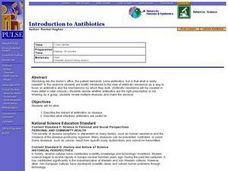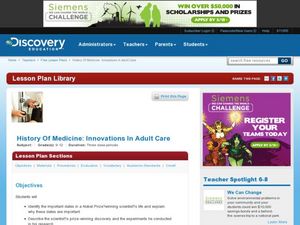Curated OER
Industrialization
Eleventh graders examine government regulations. In this industrialization lesson, 11th graders look into what was going on inside American factories during the era. Students read excerpts of The Jungle and watch selected video clips...
Curated OER
Creative Writing
Students criticially read an unfinished creative writing piece, answer factual questions concerning the piece, and then finish the story or create their own story about their own neigborhood and possible environmental issues.
Curated OER
Water Creative Writing
Students red and discuss an example of a biographical essay. They read The Last of the Falling Tide by Car Hiassen, answer factual questions concerning the work, and create their own story about a natural place they are familiar with ,...
Curated OER
Solving Environmental Problems
Students identify a community environmental problem and possible solutions. They analyze the connection between the problem and the solutions and the importance of it to the local community. Students then draw a picture of an...
Curated OER
Land Use and Lawmaking in California
Students investigate the laws of using land. In this California Government lesson, students examine the many uses of land in California and find an environmental issue they care about. Students write a letter to a politician...
Curated OER
Civilizations of the Americas
Study and compare multiple aspects of both Aztec and Inca civilizations. Young historians explain how each of the empires came to be, and how they were both defeated by the Spanish. The resource starts out as a good lesson, but is...
Curated OER
Children's Literature Across the Curriculum Ideas-Harvey Potter's Balloon Farm
Students read Harvey Potter's Balloon Farm by Jerdine Nolen Harold. They complete a variety of cross-curricular activities surrounding the study of balloons. Included are reading, art, math, science, writing, social studies, and library...
Curated OER
Get to Know Your City
Third graders research the history of their home city and how it's development was influenced by different groups of people. They present their research information to the class.
Curated OER
A Changing Society
Seventh graders examine Chaucer's work about the medieval times. In groups, 7th graders imagine what modern activities could replace some tasks used in medieval times.
Curated OER
Unintended Consequences: Policies that Impact Migration
Students examine the cause-and-effect relationship between the Agricultural Adjustment Acts of the New Deal or the 1965 Voting Rights Act and African-American migration. They write an essay evaluating the effectiveness of the Voting...
Curated OER
Wappo Indians of Napa County
Third graders describe the American Indian nation in their local region long ago and in the recent past in terms of national identities, religious beliefs, customs, and various folklore traditions. They synthesize their findings into a...
Curated OER
Portland Observatory - Images
Students encounter the history and use of a Portland landmark. They explore history, communications, science, and museum visits. Students incorporate how to explore in the Maine Memory Network documents as well. An adventure for any...
Curated OER
Escape From Gilleleje
In this social studies worksheet, students read the history surrounding the captivity of the Jews in Denmark. They use the map for a geography lesson.
PBS
Stories of Painkiller Addiction: Contemplating Nature vs. Nurture
Does having an addict in your family make it more likely to become one yourself? Explore the genetic risk factors, as well as the prominent environmental influences, for substance addiction in a lesson that encourages awareness and open...
EngageNY
Building Background Knowledge: How Canada’s Natural Resources Meet the Needs and Wants of People Today
Learners follow along as the teacher reads Products of Mining in Canada: From Batteries to Vehicles aloud. They then discuss the meaning of key terms and determine the gist of the text. Pupils do a second read and complete a graphic...
Curated OER
Tread Lightly: Where We Stand
Students explore the concept of ecological footprints. For this environmental stewardship lesson, students calculate their ecological footprints and consider how to reduce them.
Curated OER
Looking at French Decorative Arts
Students research the history of trade in porcelain wares from Asia and the quest to re-create true hard-paste porcelain in Europe and art in French society. In this French art lesson, students research and discuss the possible...
Curated OER
Maya Math: From Zero to Nineteen
Students explore counting methods of the ancient Maya, and practice identifying Maya number glyphs.
Curated OER
Learning from Letters and Other Mail
Students explore the history of our mail system. In this postal lesson plan, students evaluate mail as a means of communication, create a mail system in their classroom where they can send and receive mail. Once the students receive...
Curated OER
Introduction to Antibiotics
High schoolers describe the impact of antibiotics on disease. They describe what infections antibiotics are useful for. Students are introduced to the idea of antibiotic resistance as a way to focus on antibiotics and the mechanisms by...
Curated OER
Memorable Singer 1929-1949
Students examine how Louis Armstrong's fame spread from the African American community to the whole world. They examine how his singing style influenced both popular and jazz musicians by participating in guided listening of his musical...
Curated OER
Innovations In Adult Care
Students study scientists and the important Nobel Prize dates. In this investigative lesson students divide into groups and watch a program then complete a project.
Curated OER
World Religion At A Glance
Ninth graders research and assigned religion and fill out information they gather on their "Special Assingment Instruction Sheet." They create a sample brochure about the religion they researched, edit the brochure with another student...
Curated OER
Signs of Our Times
Students view photographs of the signs and symbols in their local community. As a class, they note the reason for the signs and write the words on the board. Individually, they complete a worksheet in which they match the symbols with...


